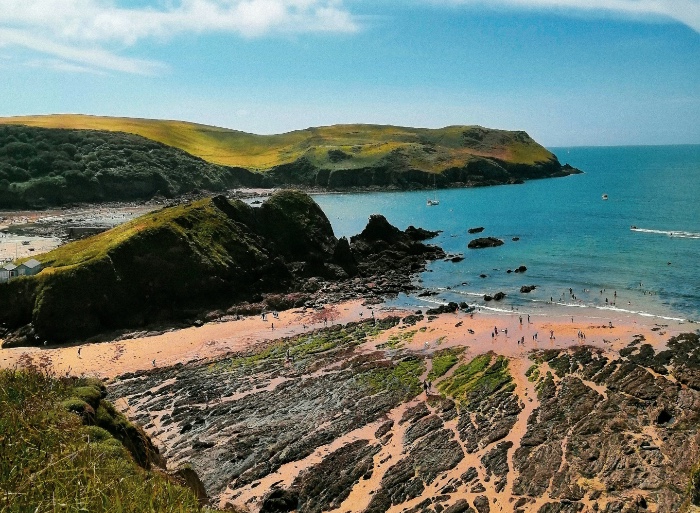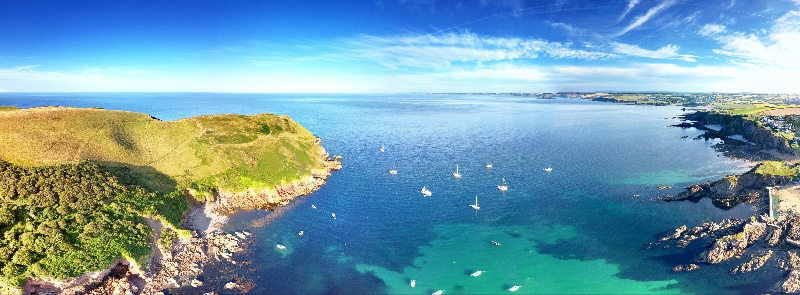Hope Cove Tide Times
For accurate tide predictions forecast for Hope Cove in South Devon, see the table below. This shows today's tide times including the next high tide. This tidal forecast for Hope Cove is provided by the UK Hydrographic Office.
| High / Low | Time (24hr) | Height |
| Wednesday 24th December | ||
| Low Tide | 02:02 | 1.38m |
| High Tide | 08:11 | 4.78m |
| Low Tide | 14:25 | 1.32m |
| High Tide | 20:36 | 4.45m |
| Thursday 25th December | ||
| Low Tide | 02:37 | 1.45m |
| High Tide | 08:47 | 4.74m |
| Low Tide | 15:02 | 1.35m |
| High Tide | 21:15 | 4.39m |
| Friday 26th December | ||
| Low Tide | 03:14 | 1.53m |
| High Tide | 09:28 | 4.70m |
| Low Tide | 15:43 | 1.42m |
| High Tide | 22:00 | 4.33m |
| Saturday 27th December | ||
| Low Tide | 03:58 | 1.63m |
| High Tide | 10:16 | 4.62m |
| Low Tide | 16:31 | 1.54m |
| High Tide | 22:52 | 4.28m |
| Sunday 28th December | ||
| Low Tide | 04:50 | 1.76m |
| High Tide | 11:11 | 4.54m |
| Low Tide | 17:31 | 1.68m |
| High Tide | 23:53 | 4.25m |
| Monday 29th December | ||
| Low Tide | 05:57 | 1.88m |
| High Tide | 12:17 | 4.45m |
| Low Tide | 18:46 | 1.77m |

Accessing Hope Cove Beaches at Different Tide Times
Visiting Hope Cove is a highlight of any South Devon holiday, but it’s essential to check the tide times before you go. There’s a chance you could get cut off if you’re walking between the beaches or exploring the rocks during a rising tide, so plan ahead to give yourself plenty of time to enjoy the area safely.
Both Inner Hope and Outer Hope beaches are tidal, meaning that their size and accessibility change dramatically throughout the day. At high tide, the beaches are much smaller, and the sea comes close to the sea wall and slipways. At low tide, the beaches open right out, revealing golden sands and rocky outcrops ideal for rock pooling.
General Beach Safety Advice
Check the tide times before you arrive and again before setting off on coastal walks or exploring rock pools.
Check the weather forecast and UV index — especially on sunny days when the breeze can disguise the strength of the sun.
Wear sun cream, even when it's cloudy.
Stay aware of changing conditions. The sea can come in quickly at certain spots in Hope Cove.
What Are the Beaches Like at High and Low Tide?
Hope Cove has two distinct beaches:
- Outer Hope (the main sandy beach in front of the village)
- Inner Hope (the smaller beach near the old lifeboat station)
At high tide, Outer Hope is still usable but much narrower, while Inner Hope can almost disappear under the waves. It’s not a great time for sunbathing, but perfect if you just want a quick dip or enjoy watching the waves crash against the sea defences.
At low tide, both beaches are stunning. The sand stretches right out, and a hidden world of rock pools and sea lifeemerges. Crabs, anemones, and small fish can often be found between the rocks. Low tide also connects the two beaches more easily, giving adventurous families a chance to explore the coastline.
Photographers will love the changing colours of the rocks and the wide open views, while children can enjoy building sandcastles with plenty of time before the sea returns.
Hope Cove Weather Forecast
To get an accurate weather forecast for hope cove, we recommend visiting the following weather forecast websites:

Is the Beach Wet? Why Not Have a Cream Tea Instead?
If you've arrived at Hope Cove full of plans to sunbathe, swim, or stroll the sands — only to find the tide's in, the rain’s on, or the sea’s swallowed the beach — don’t worry. That’s coastal life, and it's all part of the charm.
But here’s the good news: Devon cream tea waits for no tide.
There’s no better excuse to head up from the shoreline and tuck into something sweet. Whether you’re drying off, killing time before the tide falls, or simply rethinking your sandals-and-sunglasses strategy, a warm scone, fruity jam, and a dollop of clotted cream is the perfect consolation prize. Add a pot of strong West Country tea, and you’ve got the makings of a truly tide-proof afternoon.
Tide Theory
Tides around the UK, including the South Devon coast and Hope Cove, are driven primarily by the gravitational pull of the moon and, to a lesser extent, the sun. The UK experiences semidiurnal tides, meaning there are typically two high tides and two low tides each day — one approximately every 12 hours and 25 minutes.
This pattern is caused by the rotation of the Earth beneath a pair of tidal bulges created by the moon’s gravitational pull. The result? A regular rhythm of the sea rising and falling, which we call the rising tide (as the water comes in) and the falling tide (as the water goes out).
The height and timing of the tides can also be influenced by the lunar cycle — particularly the new moon and full moon, which create spring tides with higher highs and lower lows. In contrast, neap tides occur during the first and third quarter of the moon, leading to more moderate tidal differences.
Tides and the Sun: Sunrise, Sunset and Coastal Activities
While tides are governed by the moon, sunrise and sunset also play an important role in planning your coastal adventures. If you're heading out early to catch the sunrise or staying late for golden-hour photography, it’s vital to know whether the tide will be rising or falling.
A rising tide at sunrise might mean less beach space and faster-moving water — important to note if you’re setting up for a beach picnic or launching a kayak. A falling tide at sunset, on the other hand, can reveal rock pools and stretches of golden sand perfect for walking or shell collecting.
Tide Awareness for Hope Cove
Hope Cove is a moon-coast based environment: that is, its tide cycle is closely linked to the lunar position. Because the beaches at Hope Cove are relatively small and enclosed, the difference between high and low tide is dramatic. At high tide, the beach may all but vanish; at low tide, there is a vast, walkable expanse of sand and rock.